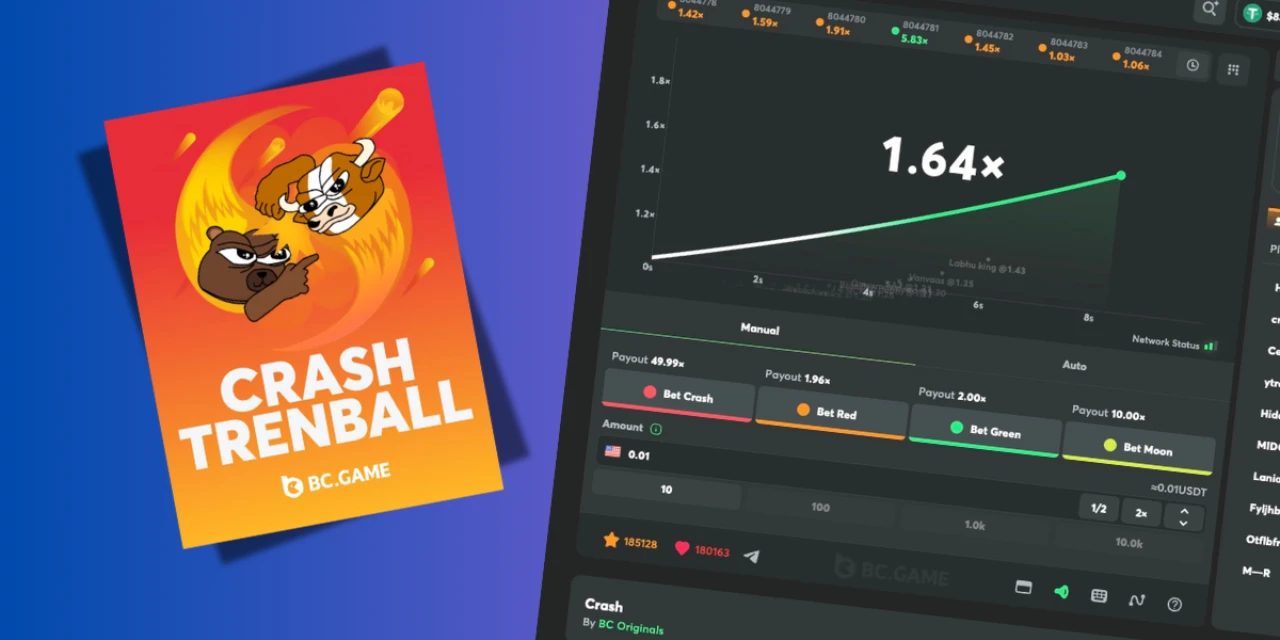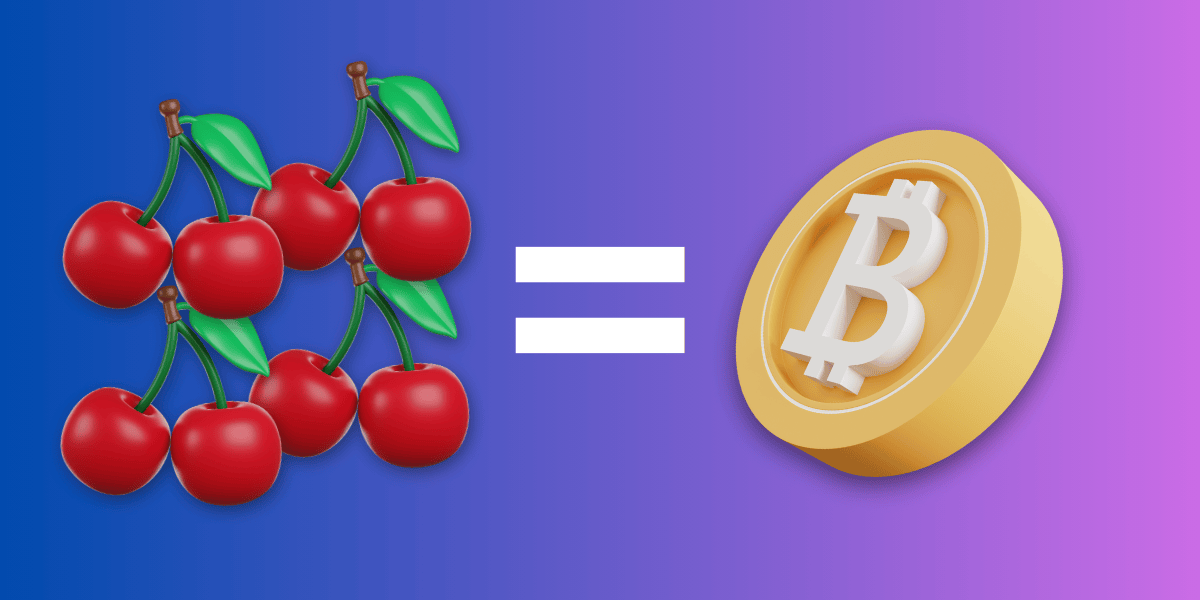
How to Read Pay Tables in Crypto Casino Games
Diving into a casino game without checking its pay table or game info is like playing a sport without knowing the rules. You’re putting yourself at an unnecessary disadvantage.
A pay table or info section is your roadmap to understanding any game, be it slots, poker, or Crash.
In this guide, I’ll show you how to read casino game pay tables like a pro.
Key Takeaways 🔑
- Pay tables reveal payouts, rules, and different features.
- They’re helpful for understanding slots, poker, and other games.
- You can use them to strategize smarter and manage risks.
- Games like Crash and Plinko use more interactive info instead.
What Is a Pay Table?
A pay table (A.K.A game info screen) is a breakdown of how a casino game works.
It shows you everything from symbol values to special features, payout odds, card combos, and game rules.
While the format may vary, slots sometimes use literal tables, while games like poker or roulette provide detailed charts, the purpose is the same: to help you play smarter.
Why You Should Use Them
Would you invest your money in a market you don’t understand? Hopefully not. Using a pay table, like any research, can help you:
- Avoid mistakes: Misunderstanding a rule or payout can cost you money.
- Strategize better: You’ll know which symbols, hands, or bets to prioritize.
- Understand risk vs. reward: Details like RTP and volatility help you manage your bankroll.
Where to Find the Pay Table?
It depends on the game, but in most cases, you should be able to find a question mark icon or a ‘Help’ button on the main game screen.
Occasionally, three stacked lines will open up the pay table or game info box.
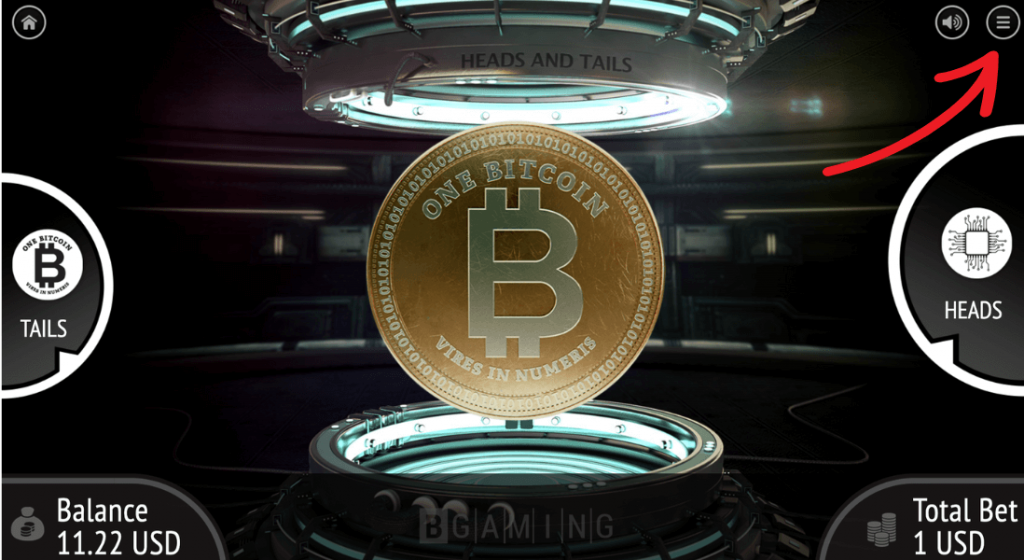
How Pay Tables Vary Per Game
There’s no universal crypto casino pay table. As I mentioned before, the format often changes depending on the genre of game you’re playing.
Here’s a quick overview of how to understand a few kinds of them:
1. Slots: Viewing Paylines, Symbols, and Features
If you can find me one modern slot game without a pay table, I’ll be very surprised. Slots are the most common games with pay tables, usually because each slot machine can differ so wildly from the next.
These tables explain:
- Symbol values: Which symbols pay the most and how many you need for a win.
- Paylines or clusters: The patterns required to win.
- Wilds and scatters: Their functions and bonus triggers.
- Bonus features: Free spins, multipliers, jackpots, and more.
- RTP and volatility: Indicators of long-term payout rates and risk levels.
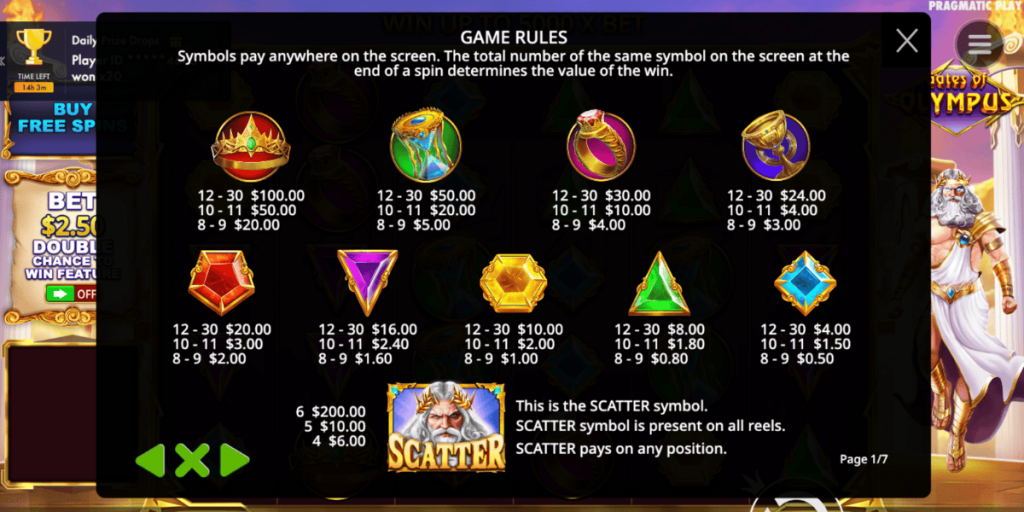
In Gates of Olympus (pictured above) the pay table shows:
- Crown symbols pay the highest.
- Scatters trigger free spins when four or more land on the reels.
- Multipliers stack up during free spins for massive payouts.
Sure, you could probably get away without knowing this information (the slot will automatically tally up and pay out your winnings) but knowing which symbols to hope for definitely makes the game more exciting.
2. Poker: Learning Hand Rankings and Payouts
Poker pay tables (especially in video poker) are straightforward but critical. They show:
- Hand rankings: Royal flush, straight flush, four of a kind, etc., in descending order of value.
- Payouts: How much each hand is worth, often varying with bet size.
- Game Variants: Rules and payouts differ between versions (e.g., Jacks or Better vs. Deuces Wild).
Let’s use Stake Casino’s in-house video poker game as an example:
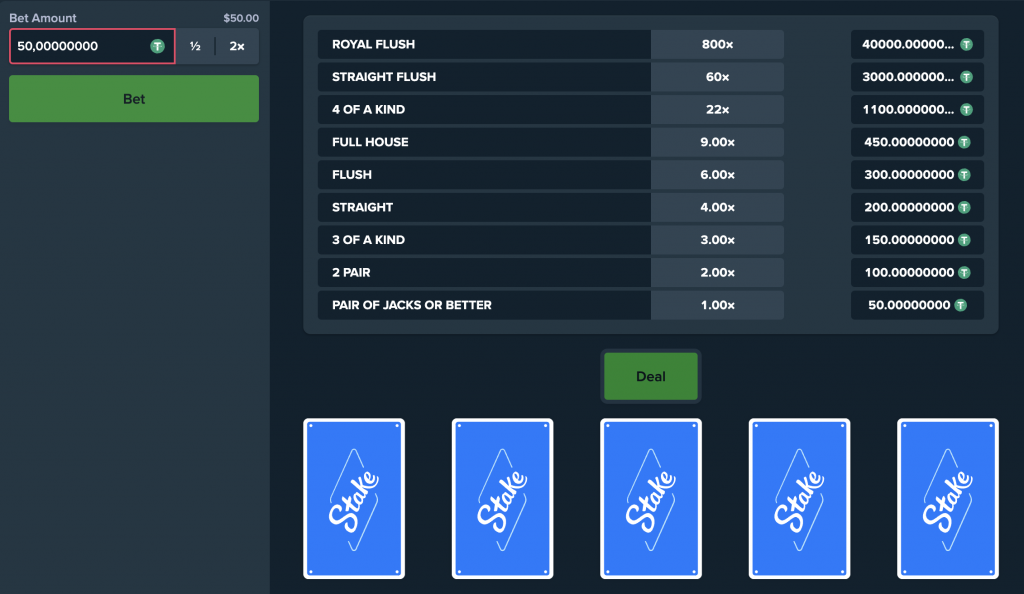
In this pay table, you can see:
- The different hands you can build.
- The bet multiplier for each hand (with Royal Flush being the highest at 800x)
- Your prospective payout based on your bet amount.
Of course, not every poker pay table will be so detailed, but at a minimum you’ll be able to see the different hands and payout multipliers.
3. Blackjack: Understanding Payouts and Side Bets
Blackjack doesn’t always have a “table,” per se, but the game info section will explain:
- Standard payouts: Blackjack usually pays 3:2, but some games lower it to 6:5; bad news for your wallet.
- Side bets: Options like Perfect Pairs or 21+3, which have unique payouts.
- House rules: Variations like dealer stands on soft 17 or doubling after splits.
Looking at a standard Live Blackjack game, you’ll see something like this:
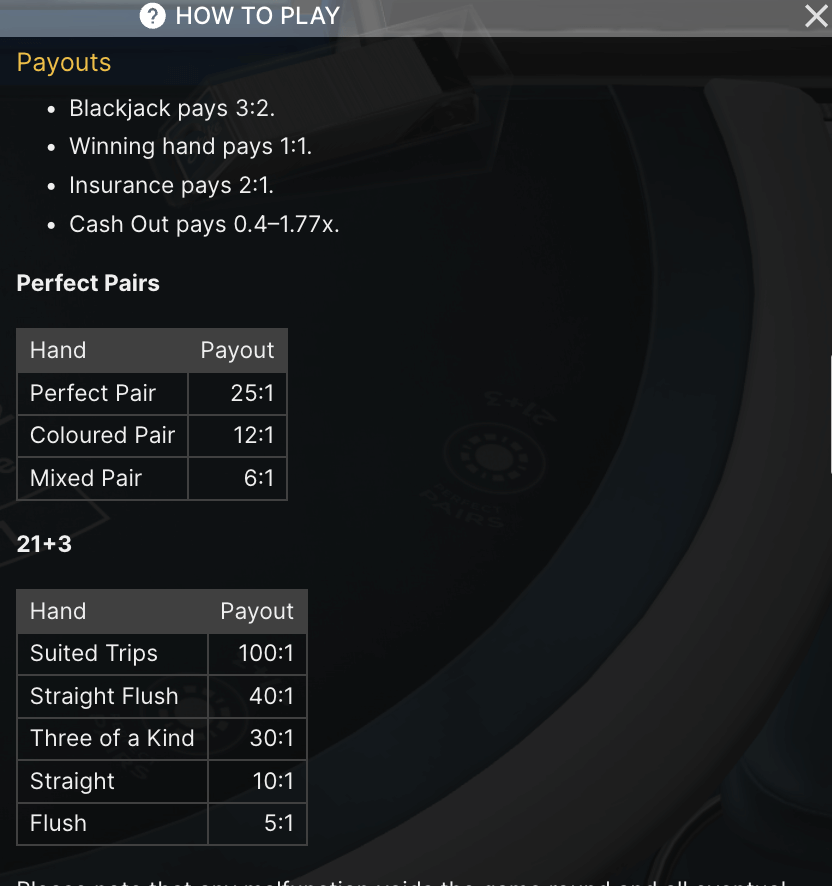
In any given blackjack pay table, you should be able to determine:
- The general payout (usually 3:2)
- The Perfect Pairs side bet offers and their payouts.
- Other side bets like 21+3 and their payouts.
Understanding these payouts can help you decide whether to stick to standard bets or spice things up with side bets.
4. Roulette: Discovering Odds for Inside and Outside Bets
Roulette pay tables are still useful, even though they can be redundant. Why? Well, on some roulette tables, the payout per bet is already displayed, but not all.
Even so, it doesn’t hurt to get those extra details, like learning about:
- Inside bets: Straight-up (35:1), split (17:1), street (11:1), etc.
- Outside bets: Red/black, odd/even, columns, and dozens (all 1:1 or 2:1).
Let’s look at BC.Game’s in-house roulette as an example:
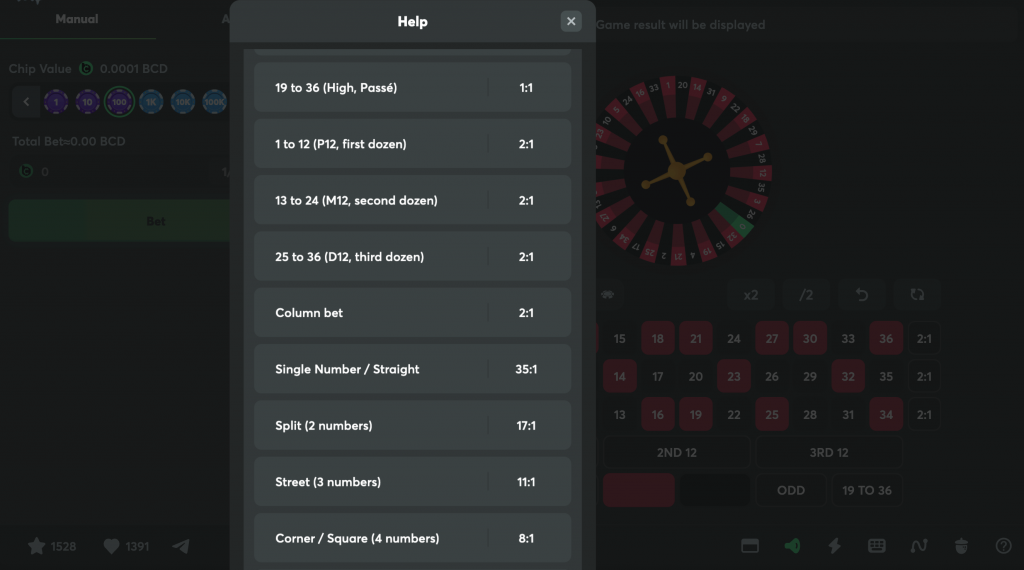
Above, you can see that:
- Pockets 19 to 36 will pay out 1:1.
- Straight will pay out 35:1.
- The corner will pay out 8:1.
Knowing these odds lets you mix high-risk bets with safer options, depending on your strategy.
5. Specialty Games: Interactive Info Screens
Some crypto casino games, like Crash, Plinko, or Mines, don’t use traditional pay tables. Instead, they offer more interactive info:
- Crash: Multiplier climbs until it “crashes.” The game info shows how payouts scale with risk, and what strategies may be effective.
- Plinko: Displays odds and payouts for each row based on ball placement and your chosen level of volatility/risk.
- Mines: Explains how increasing the number of mines raises potential payouts.

As seen in the screenshot above, you can interact with BC.Game’s Plinko by hovering over the pocket to see the win chance and potential payout amount.
How to Make the Most out of Casino Game Pay Tables
Here’s how you can use pay tables to play smarter:
- Choose games more strategically: You can compare RTPs and volatility across slots. For table games, you can pick variations with better payouts (e.g., 3:2 blackjack over 6:5).
- Optimize your bets: Know where the value is, whether it’s chasing high-value symbols by buying bonus rounds or sticking to lower-risk bets.
- Focus on features: Some slots are all about bonuses, while others rely on base game payouts. Knowing this info can help you adjust your gameplay accordingly.
Final Thoughts
Whether you’re playing slots, poker, or betting on roulette, pay tables are your key to smarter, more strategic gameplay.
Next time you start a game, take a minute to review the pay table or game info. It’s a simple step, but it can make a massive difference to your experience. After all, the more you know, the better your chances.






